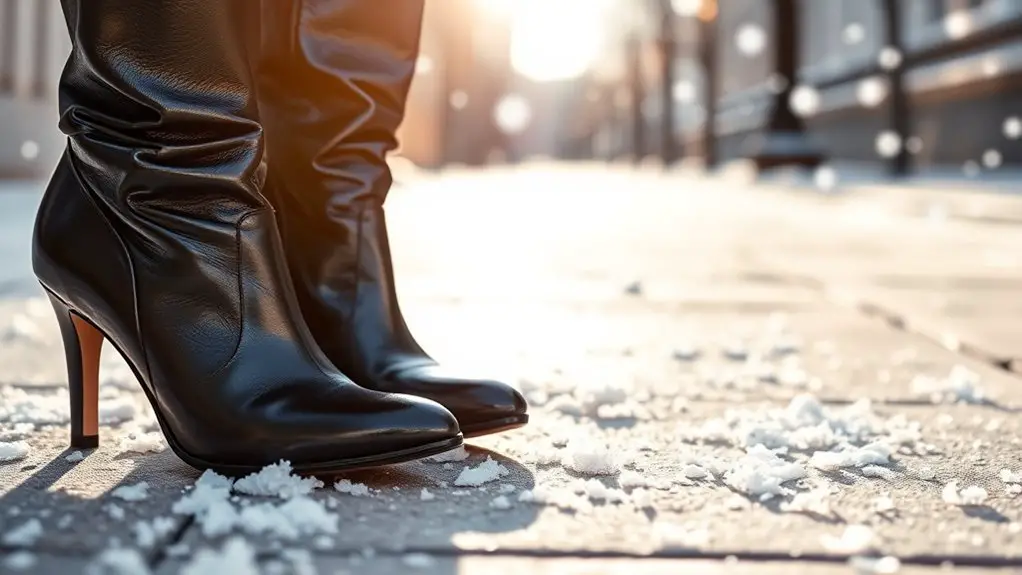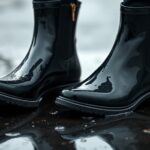To protect your heels from snow and ice damage, start by choosing water-resistant materials like treated leather and opt for rubber soles for better traction. Use high-quality waterproofing sprays to repel moisture and salt stains. Consider adding heel protectors and ice grips for enhanced stability and to maintain structure. Properly store your heels in a cool, dry place, and regularly clean them to remove dirt and moisture. There’s more to explore on maintaining your winter footwear effectively.
Choose the Right Materials for Winter Heels
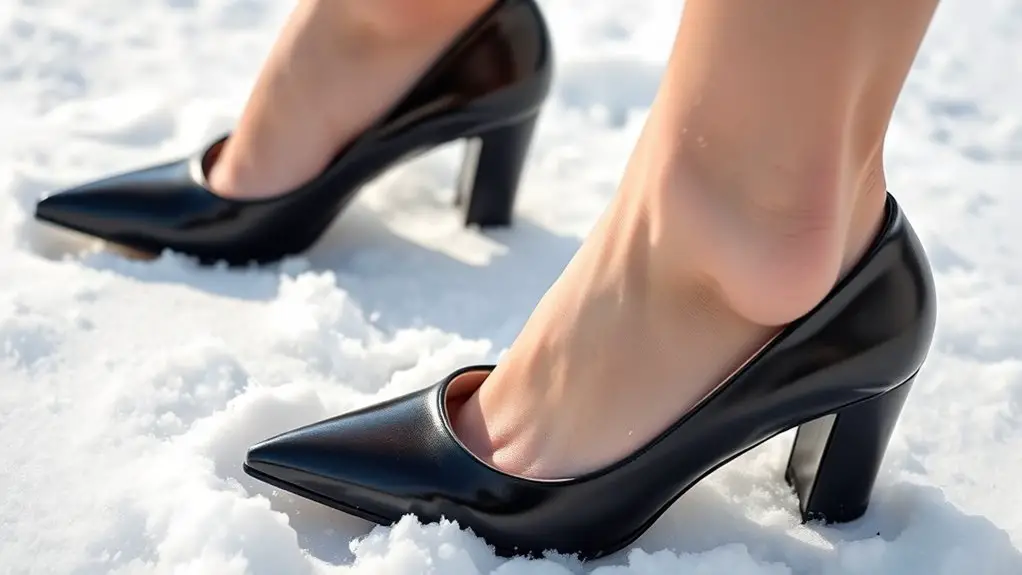
When it comes to winter heels, choosing the right materials can make all the difference in protecting your shoes from snow and ice damage. Opt for heels made from water-resistant materials like treated leather or synthetic fabrics. These materials not only offer durability but also help prevent moisture from penetrating your shoes, which can lead to unsightly stains and deterioration.
Additionally, consider rubber soles for better traction on slippery surfaces. This combination of heel materials guarantees you maintain both style and safety during winter fashion outings. Avoid delicate fabrics like suede or canvas, as they absorb water and can be challenging to clean.
When shopping for winter heels, prioritize functional designs that embrace practicality without sacrificing elegance. Keep in mind that the right materials can allow you to navigate the season confidently while keeping your fashion game strong.
Invest in Protective Sprays and Treatments
Protect your heels by investing in high-quality protective sprays and treatments designed specifically for winter conditions. These products not only create a barrier against moisture but also enhance the durability of your heels. When selecting a protective spray, look for options with robust protective properties to guarantee your heels stay in top shape throughout the season.
Here are some tips to take into account:
- Waterproofing: Choose sprays that repel water and prevent salt stains.
- Material Compatibility: Confirm the treatment is suitable for the materials of your heels.
- Ease of Use: Opt for products with a simple spray application for even coverage.
- Long-lasting Protection: Select treatments that provide extended protection, requiring fewer reapplications.
Use Heel Protectors and Ice Grips
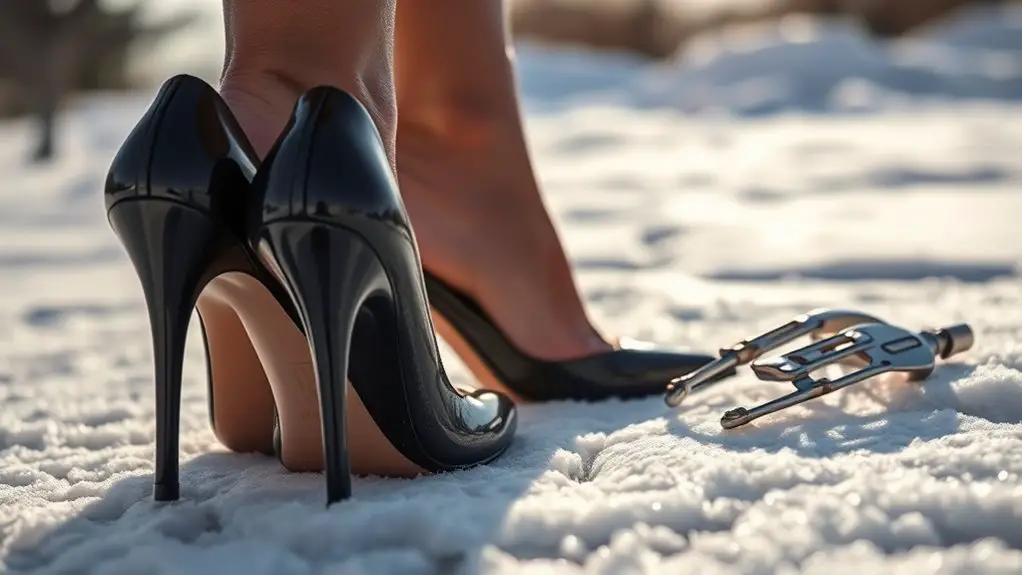
Using heel protectors and ice grips can make a significant difference in maintaining the integrity of your favorite footwear during winter. There are various heel protector types available, such as adhesive pads and rubber caps, which shield your heels from snow and ice damage. These protectors not only prevent scuffing but also help in maintaining the shape and structure of your heels.
Ice grips, on the other hand, are designed to enhance traction on slippery surfaces. They easily attach to your footwear, providing additional stability and reducing the risk of slips and falls. The benefits of using ice grips extend beyond safety; they can also prevent wear and tear on your soles, extending the life of your shoes. By investing in these accessories, you’re taking proactive steps to keep your heels looking great and functioning well throughout the winter months.
Store Your Heels Properly During Winter
After taking steps to safeguard your heels with protectors and grips, it’s important to contemplate how you store them during the winter months. Proper winter storage can prevent damage and guarantee your shoes remain in top condition for the next season. Here are some practical tips for effective shoe organization:
Safeguarding your heels is just the start; proper winter storage is key to keeping them in pristine condition.
- Choose a cool, dry space: Avoid damp areas that could lead to mold or mildew.
- Use shoe boxes or bags: Keep your heels protected from dust and scratches.
- Insert shoe trees: They help maintain the shape of your heels and prevent creasing.
- Elevate your shoes: Store them off the ground to avoid moisture seeping in.
Clean and Maintain Your Heels Regularly
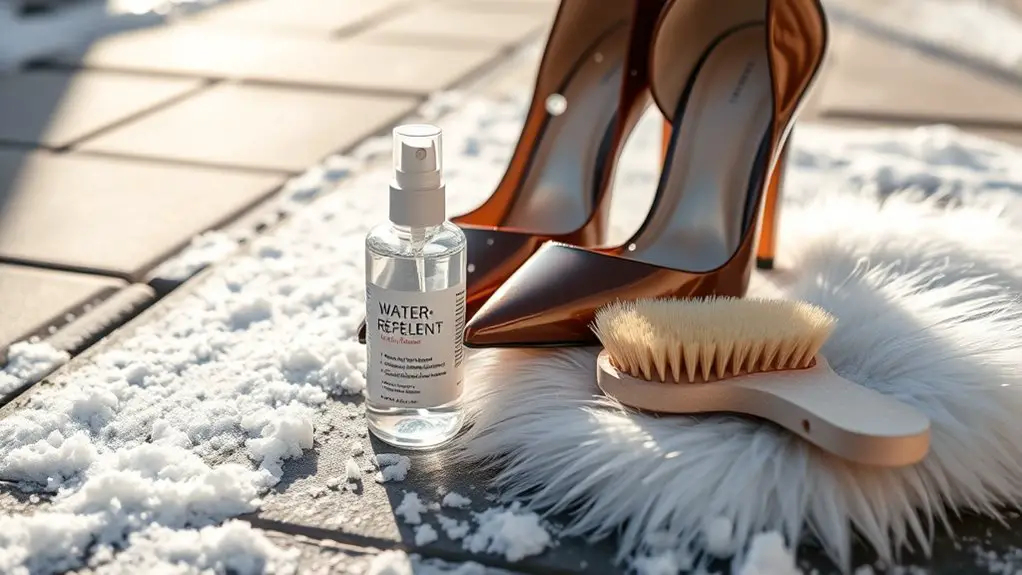
To keep your heels in top shape, establish a regular cleaning routine that removes dirt and salt residue. Conditioning leather materials not only enhances their appearance but also helps maintain their flexibility and prevents cracking. Don’t forget to inspect your heels for any signs of damage, as catching issues early can save you from more extensive repairs down the line.
Regular Cleaning Routine
While it’s easy to overlook the upkeep of your favorite heels during winter, a regular cleaning routine is essential for protecting them from the damaging effects of snow and ice. Implementing a consistent heel cleaning strategy will guarantee they stay in top shape throughout the season.
Here are some practical tips for winter care:
- Remove salt stains with a damp cloth immediately after exposure.
- Clean the soles regularly to prevent buildup of grime and snow.
- Dry your heels thoroughly after wearing them in wet conditions.
- Store your heels in a cool, dry place to avoid moisture damage.
Conditioning Leather Materials
Since leather is a natural material that can be susceptible to moisture and temperature changes, conditioning your heels regularly is crucial for maintaining their appearance and longevity. Use a high-quality leather conditioner that provides nourishment, helping to keep the material supple and prevent cracking. Apply the conditioner evenly using a soft cloth, making sure to cover all areas, especially seams and creases. This not only enhances the leather’s appearance but also offers moisture protection, creating a barrier against the harsh elements of snow and ice. Remember to condition your heels every few months or more frequently if they’re exposed to extreme conditions. By doing this, you’ll guarantee your heels remain beautiful and durable throughout the winter season.
Inspect for Damage
Regularly inspecting your heels for damage is essential to keeping them in top shape, especially during winter months. A thorough heel inspection can prevent minor issues from escalating into costly repairs. Here’s what to focus on during your damage assessment:
- Check for cracks in the heel material, which can lead to further deterioration.
- Examine the sole for wear and tear, ensuring it provides adequate grip on slippery surfaces.
- Inspect the stitching for fraying or looseness, as this can compromise structural integrity.
- Look for discoloration or stains that may indicate salt damage from snow and ice.
Opt for Stylish Alternatives on Slippery Days
When traversing snowy and icy conditions, choosing the right footwear can make all the difference in maintaining both style and safety. Instead of risking your favorite heels, consider opting for fashionable boots that offer both protection and flair. Look for styles that feature sturdy soles with good traction, ensuring you won’t slip while still showcasing your unique style.
Another great option is winter-friendly wedges. These provide additional stability and support without sacrificing height, allowing you to navigate slippery surfaces confidently. Choose designs that incorporate waterproof materials and insulated linings for extra warmth.
Pair these stylish alternatives with your winter wardrobe for a chic and practical look. Remember, it’s not just about avoiding damage to your heels; it’s also about keeping your footing secure. By selecting the right footwear, you can enjoy the winter months without compromising your personal style.
Frequently Asked Questions
Can I Wear My Favorite Heels in Snow Without Damage?
You shouldn’t wear your favorite heels in snow, as they can get damaged. Prioritize heel care by choosing winter footwear designed for icy conditions, ensuring they’re both stylish and safe for your winter outings.
How Do I Know if My Heel Protectors Fit Properly?
To guarantee your heel protectors fit properly, check the size according to fitting guidelines for each heel protector type. They should snugly cover your heels without slipping, providing secure protection while maintaining comfort and stability.
What Types of Heels Are Most Susceptible to Winter Damage?
Stiletto heels, with their delicate structure, contrast sharply against sturdy winter materials. Leather heels are particularly susceptible to winter damage, as cold and moisture can ruin their finish, making proper care essential for preservation.
Are There Specific Brands of Protective Sprays You Recommend?
For protective sprays, consider brands like Scotchgard and Kiwi. They offer excellent protective features against moisture and stains, guaranteeing your heels stay safe. Always test a small area first to verify compatibility with your footwear.
How Can I Tell if My Heels Need Professional Cleaning?
Did you know 70% of shoe damage comes from neglect? If you spot signs of damage like scuffs, discoloration, or odor, consider professional cleaning methods for your heels to restore their original beauty effectively.

